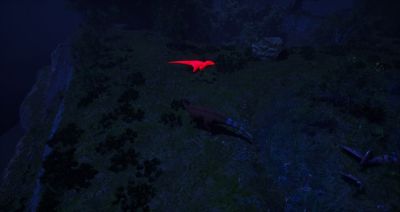Difference between revisions of "Ability Calls"
Kinispino o (talk | contribs) |
Kittennoodle (talk | contribs) |
||
| (9 intermediate revisions by 2 users not shown) | |||
| Line 1: | Line 1: | ||
| − | + | Ability calls are a special type of [[Abilities|ability]] given to certain creatures in Beasts of Bermuda. The [[Parasaurolophus]] and the [[Acrocanthosaurus]] are currently the only two creatures to have an ability call. To use their ability, they must use the [[Keybinding|Creature Ability key]] (default “Z”). | |
| − | The alarm call plays a loud warning cry that varies depending on the significance of the threat. | + | The [[Parasaurolophus]]' ability call is an alarm call. When used, it plays a loud warning cry that varies in length depending on the significance of the threat. If faced with one of the least threatening predators, such as a [[Velociraptor]], it will let out a short call. If faced with a significant threat, such as a [[Tyrannosaurus rex]], it will let out a long warning cry. Creatures that have received an alarm call will be highlighted for anyone in the same group as the Parasaurolophus who has used the ability. The alarm call does not work on fellow herbivores. |
| − | In the case of the [[Acrocanthosaurus]] | + | In the case of the [[Acrocanthosaurus]], its ability call is both a tracer and a debuff. It will highlight the affected individual, and lower the amount of damage it can inflict. Its ability call does not affect pack members. |
| − | Using the | + | Using the ability call consumes 30 [[Ability|ability power]]. In some situations, such as during an [[Weather|intense storm]], the visibility it provides can also be helpful given the fact that it highlights the marked player in bright, emissive red or purple. Successfully using the ability call is a two step process. When the [[Abilities|ability key]] is pressed, a small cursor will appear at the center of the player's screen. Releasing the ability button with the cursor over another player, they will become highlighted for 10 seconds, the ability call will be heard, and for the Acrocanthosaurus, its prey will receive a debuff for as long as the ability call is in effect. All players can hear the call. |
| − | Return to [[Main Page]] or see [[ | + | Return to [[Main Page]] or see [[Communication and Roaring System]]. |
| − | [[File:Alarmcall.jpg|right|thumb|400px|border|]] | + | [[File:Alarmcall.jpg|right|thumb|400px|border|A [[Parasaurolophus]] uses its ability call to highlight a [[Megalosaurus]].]] |
| + | |||
| + | [[Category:Mechanics]] | ||
Latest revision as of 16:58, 15 October 2020
Ability calls are a special type of ability given to certain creatures in Beasts of Bermuda. The Parasaurolophus and the Acrocanthosaurus are currently the only two creatures to have an ability call. To use their ability, they must use the Creature Ability key (default “Z”).
The Parasaurolophus' ability call is an alarm call. When used, it plays a loud warning cry that varies in length depending on the significance of the threat. If faced with one of the least threatening predators, such as a Velociraptor, it will let out a short call. If faced with a significant threat, such as a Tyrannosaurus rex, it will let out a long warning cry. Creatures that have received an alarm call will be highlighted for anyone in the same group as the Parasaurolophus who has used the ability. The alarm call does not work on fellow herbivores.
In the case of the Acrocanthosaurus, its ability call is both a tracer and a debuff. It will highlight the affected individual, and lower the amount of damage it can inflict. Its ability call does not affect pack members.
Using the ability call consumes 30 ability power. In some situations, such as during an intense storm, the visibility it provides can also be helpful given the fact that it highlights the marked player in bright, emissive red or purple. Successfully using the ability call is a two step process. When the ability key is pressed, a small cursor will appear at the center of the player's screen. Releasing the ability button with the cursor over another player, they will become highlighted for 10 seconds, the ability call will be heard, and for the Acrocanthosaurus, its prey will receive a debuff for as long as the ability call is in effect. All players can hear the call.
Return to Main Page or see Communication and Roaring System.
